#embroidery digitizing techniques
Text
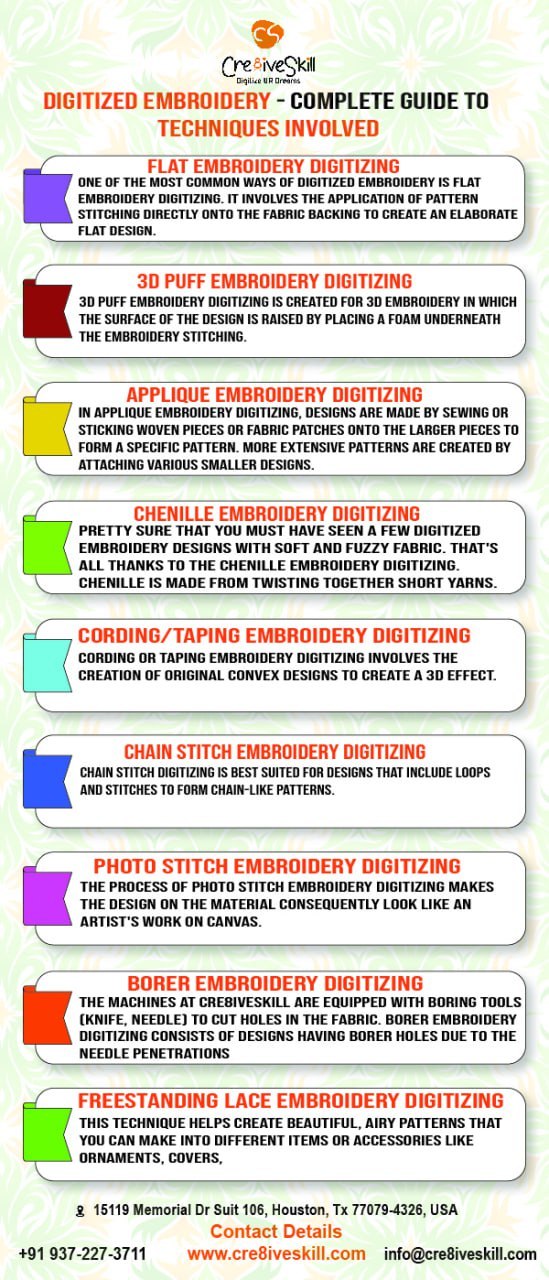
Master the art of embroidery digitizing with Cre8iveSkill's comprehensive guide. Learn essential digitized embroidery techniques useful for professional embroidery digitizers.
#cre8iveskill#digitized embroidery#embroidery digitizing#digital embroidery designs#embroidery digitizing services#digitize artwork#digitizer embroidery service#professional embroidery digitizers#digitized embroidery designs#embroidery digitizing techniques
0 notes
Text
i miss art classes so bad ngl
#relief i miss you monotype i miss you mixed media i miss youu#i really miss the structure of having to set aside hours of my week to Make Art it was so so good#and like learning new techniques!! getting to play around and go ‘this might look like shit but i wonder what will Happen!!’#having an accessible Space set aside for it…getting to come in during studio time earbuds In and spend 5 hours straight…#and my teachers were chill (which i know is def not universal lol) so it was so positive and fun#i want to learn more stuff i want to try i want to create and vibe and hang !!#tala says there’s some free classes near her we’ll have to go check it out#my toxic trait IS every two weeks i get very into the idea of learning to do a new art form that has a very high starter barrier#like a month ago it was screenprinting two weeks ago it was stained glass today it’s digital drawing tomorrow who knows#but i have food at HOME (embroidery and printmaking materials untouched for months) so i perservere
3 notes
·
View notes
Text

This is another creative sample I wanted to experiment with based on Mexicans Los Muertos make up they wear to respect the dead.
I wanted to further develop my skills and see what I can do to create a similar aspect based on Mexico traditions with the skull aesthetic make up.
To construct this textiles sample, I first choose a portrait photo of a woman and print this using the digital printer,on a black A4 size fabric.Once it was all printed off and dry, then I could start the embroidery techniques. I chose a few designs I could do on the face and improvised from a vision of mine to build a detailed and textile effect bringing this sample to life.I chose different bright colours to outline all the details and filled them in with colour by using an embroidery hoop to sustain it and not come loose.once all the details were added I went over and outlined them in black.
When I got to the teeth, I had to move fast and carefully to not go over the lines and ruin the shape. Although once I have filled them in, there was too much thread gathering and harder for the needle to go through. I finished them with the same technique for the first row and decided to try something different for the bottom teeth to see what would cooperate better. I thought of using puff binding for the teeth as it was easier for me to sew on around with lack after drying it off.
My last step was to add the 3D marigold flowers to add the last touches.I used the same method of hand stitching and some in the machine. Sewing them in the middle and twisting them around till I get the shape I wanted.
Overall this was an interesting sample I got to finish and experience the new skills with materials I could combine and build together to create something amazing based on Mexico’s traditions.I think this would be a very eye catching print on my final designs as I could interpret this as a similar textiles technique.
#get creative#Mexico#mexican style#traditions#machine and hand embroidery#hand techniques#develop and experiment#digital print on fabric
0 notes
Text
0 notes
Text

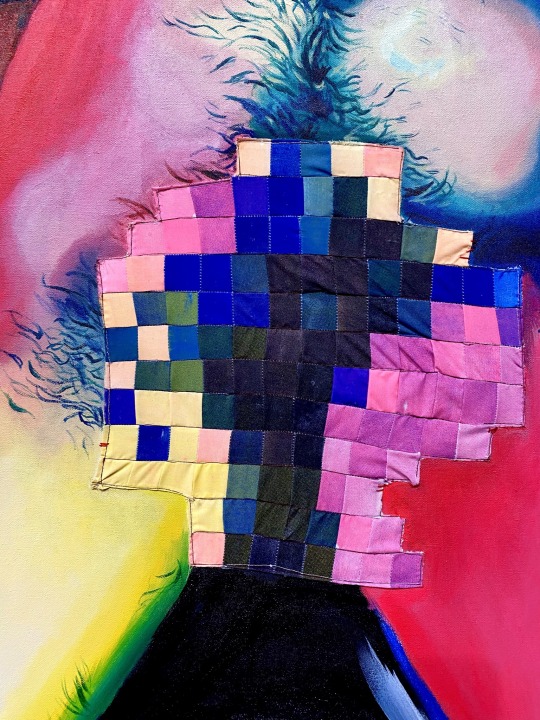
“In compliance with community guidelines” 2022, acrylic painting with screen printed quilt and embroidery, 50x80”
Click for full image!!
My thesis-painting this semester! I worked with two subjects of this pieces; 1) the censorship of queer and trans identities in our age of social media in part due to the anti-lgbt hate and laws passed this year and 2) the value of traditional art and artisanal mediums such as textiles ,in an increasingly digital art market, by appropriating digital iconography using entirely traditional mediums and techniques.
Ig: Alexgadart
8K notes
·
View notes
Text
hello!! i am troxler (trox if you're nasty) and you might know me from my xwitter @ broadcastrelay or my old experimental art blog @hand-in-hand-again .
i have a throne account here if you'd like to support my work by helping with supplies & thereby earn my eternal gratitude:
commissions are currently closed & i will update here & on xwitter if that changes!!
i do have discord if you'd like to chat, you can DM me for my username. i'm vision impaired & it's a little easier for me than tumblr DMs (scalable font. properly mapped keyboard that allows me to hit the right keys occasionally. you know 👁️)
i am sometimes slow to respond to messages, but i don't expect you to be available all the time either--i answer things when i have a moment, & i assume others do too ✌️ i have the temperament of a displaced 11th century anchorite, am simply not adapted to the tone & pace of centralized social media.
i also unfortunately cannot voice call or stream/screen share because i am a millennial (just kidding, it's because my phone is almost 9 years old & it overheats when i check my e-mail)
learn a bit more about me under the cut ✂️
i was dropped into this simulation in the early 80s, i'm a disabled artist (vision impaired - [ask me about my atrophied optic nerves] - & have some other physical Issues so i use a cane) & my wife and i host two black cats, roughly 35% of a mannequin, and a whole lot of dolls.
all my art is trad/physical media (haven't figured out a way to make digital art accessible yet. maybe someday!!) i like to sculpt in epoxy, plastilene, polymer & stone clay, i like to mold & cast in resin, make & customize various types of dolls, & build puppets; i do custom framed work, mixed media & textile stuff like sewing & embroidery; i paint in oil, acrylic, watercolor, gouache & water soluble graphite & i love ink, markers, crayons & whatever cheap & weird stuff i can get my hands on.
i have a particular affection for props, prop replicas & hypothetical in-universe items, & i like things that are handsome, durable & believable. i'm versatile & innovative, & i'm at my happiest when i'm exploring technical processes. i have quite a bit of knowledge about techniques & materials. i love a challenge!! currently all my sewing is done by hand, i have trouble controlling pedal-operated machines.
my favorite thing is horror coated in a fine layer of nostalgia & sprinkled with history. that seems highly specific, but you'd be surprised how many things fit the criteria. i tend to fixate on characters & concepts & do a lot of art about it - a habit i developed while i was re-teaching myself to draw after the changes to my eyesight. my output is largely therapeutic. sometimes people like it. maybe you will too!!
a good amount of my work is fanart & will be tagged as such/otherwise linked to the appropriate project, original work will be specified & have its own tag.
at the moment i make a lot of work related to the independent psychological horror unfiction project Welcome Home, created by ' partycoffin ' here on tumblr.
i have a more reblog-heavy sideblog, @heartshapedsignal , where i can place aesthetics, rb art that i like, Cronenbergpost & generally toss up more intense horror things & keep this one somewhat more tidy + personal-art-oriented. follow if you please; although it's unlikely i'll ever post anything too explicit, 🔞 just to be safe!!
that's all for now!! 👁️🗨️📺
29 notes
·
View notes
Text
The Anointing Screen
The Anointing Screen has been designed and produced for use at the most sacred moment of the Coronation, the Anointing of His Majesty The King. The screen combines traditional and contemporary sustainable embroidery practices to produce a design which speaks to His Majesty The King’s deep affection for the Commonwealth. The screen has been gifted for the occasion by the City of London Corporation and City Livery Companies.

The Anointing takes place before the investiture and crowning of His Majesty. The Dean of Westminster pours holy oil from the Ampulla into the Coronation Spoon, and the Archbishop of Canterbury anoints the Sovereign on the hands, chest and head. It has historically been regarded as a moment between the Sovereign and God, with a screen or canopy in place given the sanctity of the Anointing.
The Anointing Screen was designed by iconographer Aidan Hart and brought to life through both hand and digital embroidery, managed by the Royal School of Needlework. The central design takes the form of a tree which includes 56 representing the 56 member countries of the Commonwealth. The King’s cypher is positioned at the base of the tree, representing the Sovereign as servant of their people. The design has been selected personally by The King and is inspired by the stained-glass Sanctuary Window in the Chapel Royal at St James’s Palace, which was gifted by the Livery Companies to mark the Golden Jubilee of Queen Elizabeth II in 2002.
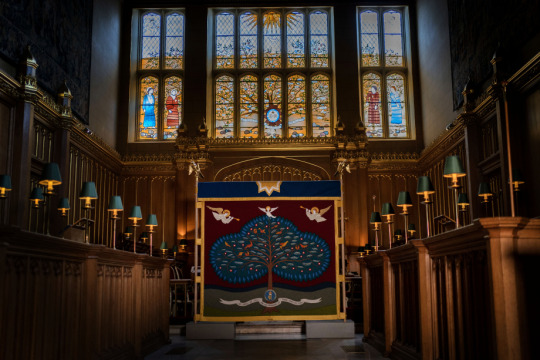
The Anointing Screen is supported by a wooden pole framework, designed and created by Nick Gutfreund of the Worshipful Company of Carpenters. The oak wooden poles are made from a windblown tree from the Windsor Estate, which was originally planted by The Duke of Northumberland in 1765. The wooden poles have been limed and waxed, combining traditional craft skills with a contemporary finish.
At the top of the wooden poles are mounted two eagles, cast in bronze and gilded in gold leaf, giving the screens a total height of 2.6 metres and width of 2.2 metres. The form of an eagle has longstanding associations with Coronations. Eagles have appeared on previous Coronation Canopies, including the canopy used by Queen Elizabeth II in 1953. Equally, the Ampulla, which carries the Chrism oil used for anointing, is cast in the shape of an eagle.

The screen is three-sided, with the open side to face the High Altar in Westminster Abbey. The two sides of the screen feature a much simpler design with maroon fabric and a gold, blue and red cross inspired by the colours and patterning of the Cosmati Pavement at Westminster Abbey where the Anointing will take place. The crosses were also embroidered by the Royal School of Needlework’s studio team.
At the Coronation Service, the Anointing Screen will be held by service personnel from Regiments of the Household Division holding the Freedom of the City of London. The three sides of the screen will be borne by a Trooper and Guardsman from each of The Life Guards, Grenadier Guards, Coldstream Guards, Scots Guards, Irish Guards, and Welsh Guards.
The screen has been gifted for the Coronation by the City of London Corporation and participating Livery Companies, the City’s ancient and modern trade guilds. His Majesty The King is a keen advocate and supporter of the preservation of heritage craft skills, and the Anointing Screen project has been a collaboration of these specialists in traditional crafts, from those early in their careers to artisans with many years of experience.
The individual leaves have been embroidered by staff and students from the Royal School of Needlework, as well as members of the Worshipful Company of Broderers, Drapers and Weavers.
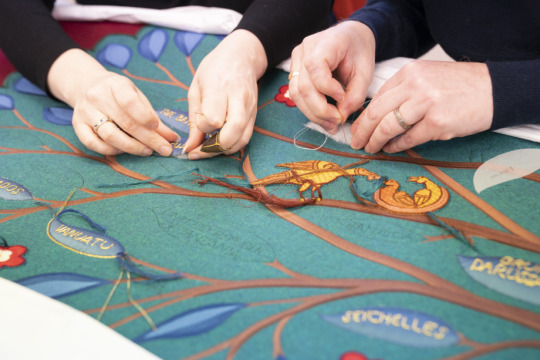
As well as heritage craft, contemporary skills and techniques have formed part of this unique collaboration. The outline of the tree has been created using digital machine embroidery by Digitek Embroidery. This machine embroidery was completed with sustainable thread, Madeira Sensa, made from 100% lyocell fibres.
The threads used by the Royal School of Needlework are from their famous ‘Wall of Wool’ and existing supplies that have been collated over the years through past projects and donations. The materials used to create the Anointing Screen have also been sourced sustainably from across the UK and other Commonwealth nations. The cloth is made of wool from Australia and New Zealand, woven and finished in UK mills.
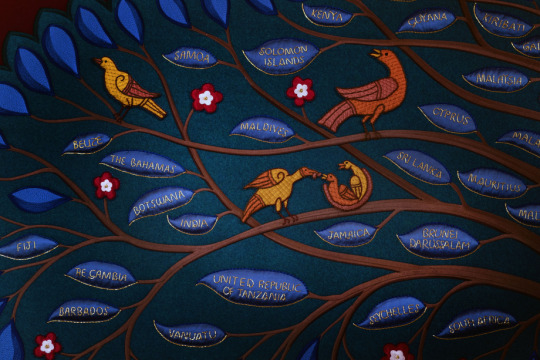
The script used for the names of each Commonwealth country has been designed as modern and classical, inspired by both the Roman Trojan column letters and the work of Welsh calligrapher David Jones.
Also forming part of the Commonwealth tree are The King’s Cypher, decorative roses, angels and a scroll, which features the quote from Julian of Norwich (c. 1343-1416): ‘All shall be well and all manner of thing shall be well’.
This design has again been inspired by the Sanctuary Window in the Chapel Royal, St James’s Palace, created for Queen Elizabeth II’s Golden Jubilee in 2002. At the top of the screen is the sun, representing God, and birds including the dove of peace, which have all been hand embroidered by the Royal School of Needlework.
The dedication and blessing of the Anointing Screen took place earlier this week at the Chapel Royal, St James’s Palace, where it was officially received and blessed by the Sub-Dean and Domestic Chaplain to The King, Paul Wright, on behalf of The Royal Household.
117 notes
·
View notes
Note
Hi! As a fellow knitter with a love for embroidery and cosplay, your Grishaverse kniting projects sound amazing! 😍 Would you be willing to share progress photos as you go? Or perhaps talk a little more about the designs, patterns, or techniques you'll use? So excited for you!
-sixofcrowsdaydreams (side blog)
Hiya, thanks so much for your interest - I'd love to share more!
My current Grishaverse knitting projects are a Healer kefta (which will probably be more along the lines of kefta-inspired than an accurate reproduction because of the material etc) and a full-size blanket of the Six Of Crows book cover (uk/us paperback edition).
For the Kefta, I'm adapting a free cardigan pattern that I'll link if anyone would like it. The pattern outlines the structure and shaping, which is mostly what I'm using it for, but is designed in a specific basket rib that I'm not using; I decided to use stockinette stitch because I think that it will be easier to embroider since I'm planning on using the Swiss Darning method. I'm teaching myself the Swiss Darning method from the wonderful book "KNIT: step by step" (Vikki Haffenden and Frederica Patmore), which I absolutely love and highly recommend. I just checked and the RRP for the book is £14.99 but I got mine for £7.99 so it might be worth looking around for where it's cheapest. I'm knitting it with DK weight yarn and so far I have the back and two front pieces complete and am currently working on the first sleeve. I used a free digital art app called Ibis Paint X to sketch out my designs for the embroidery and then overlayed them with a grid - I'm treating each square as one stitch.
The blanket it being knit in chunky weight yarn using a fair isle pattern I designed by using the same digital art app to draw and the book cover, overlay it with a grid, pixelate it, and slightly simplify the colour scheme (that was mostly due to the availability of the yarn since there are so many shades of grey in the cover). I am relatively new to colourwork, or at the very least colourwork on this scale, and this was a massive undertaking I went into with unearned confidence. Unfortunately I have now realised a massive mistake I made in the fair isle technique that means I'm going to have to undo everything I've done so far and restart, but luckily I've realised it early enough that I'm not even a quarter of the way through the project yet; if I'd done more it would be more annoying, as it stands it's not too bad but it is a setback. I've yet to decide how I'm going to back the blanket once it's complete, I have two options: 1) sew it onto either white or black fleece, 2) knit a Crooked Kingdom book cover the same size and back them onto each other. The pros of the first one is that it would give it a finished and hopefully gorgeous look, plus would be super cosy. The pro of the second option is that it would be awesome, but the con is that it might not look as neat and finished. On top of that, if I back the first one with fleece I can then knit a Crooked Kingdom one and back that with fleece, which means I get two blankets. So yeah I haven't decided yet, but I'll see how it goes and keep you guys updated.
Thanks so much for your question! If anyone has any specific requests for me to talk about regarding the knitting patterns/processes/techniques/ etc then absolutely feel free and yeah if people are interested then I will definitely put some update photos on here as I go as well :)
#asks#grishaverse#six of crows#crooked kingdom#leigh bardugo#inej ghafa#kaz brekker#jesper fahey#nina zenik#matthais helvar#wylan van eck#kanej#wesper#helnik#shadow and bone#knitting#knit#knitblr#knitters of tumblr#yarn#save shadow and bone#save six of crows#six of crows spin off#six of crows spinoff#renew shadow and bone#soc spinoff#save six of crows spinoff#grisha#grisha healer#grisha kefta
23 notes
·
View notes
Text

Colour- and Art magic in Rainbowmancy
Colour Magic
Colours are kind of the rainbow's thing, so it makes sense that colour magic is an important part of Rainbowmancy. There are many, many lists of colour correspondences out there, and I am of the opinion that these are more powerful if they are your own, so I won't make a list of colours here. (Although I will share if asked, of course!)
With Rainbowmancy there are two ways you use the colours of the rainbow: as a whole, and the individual colours separate from each other. I mostly use the colours of the rainbow as a whole, or in the case of queer witchery, the colour meanings of the Gilbert Baker pride flag.
Some ideas on how to use colour magic will be discussed below in Rainbow Magic.
Art Magic
Humans are creative beings. Cave paintings, story telling, beaded jewellery, art has been with us since the beginning. What art is and is not is a very broad discussion that I will not go into right now (but I do have thoughts). But what about art magic? To describe art magic and all it can do would be a whole essay on it's own. But to give a short explanation I can not describe it better than Molly Roberts:
"Art magick is art as the spell- the means of expressing intentions, desires, wishes and experiences.
Art magick can be a means of attracting or manifesting, but art magick can also be entirely about the process- it can be cathartic, healing, or meditative. The making of the art is the ritual itself.
I’m often pointedly asked what the difference is between art magick and crafting or scrapbooking.
Frankly, on the surface- there isn’t a difference.
Paint is paint.
An art journal is an art journal.
A project becomes art magick when it the project is tended to with a devotion, given significance, and imbued with layers of meaning for the art witch. There is an animistic dimension to art magick. This layering of meaning- the act of making something special with our love and attention, the sanctification of your creating, is the essence of enchantment."
Source: Molly Roberts
So what about art magic and Rainbowmancy? Well, painting, drawing, digital art, clay; these are all techniques that often use a lot of colour. Colour magic and art magic can go hand in hand in this regard, and like colour magic, you can focus on the individual colour of the rainbow, or the rainbow in its entirety.
With music the diatonic scale has seven notes, which can be linked to the colours of the rainbow: C-red, D-Orange, E-Yellow, F-Green, G-Blue, A-Indigo, B-Violet. A Rainbowmancer can use these notes to create rainbow symphonies, or simply resonate each not in sequence.
Dance is a wonderful art that can be adapted into art magic and rainbowmancy. Dancing with rainbow scarves, silk fans, or poi are amazing ways to get the rainbow magic to flow.
And let's not forget fiber and fabric arts such as embroidery, knitting, crochet, quilting, and sewing can be used as powerful tools to embue items with rainbow energy.
[Part of a Rainbowmancy series, masterpost here]
#rainbowmancy#rainbow magic#rainbow witch#witchcraft#witch#witchblr#rainbow#magic#art magic#art witch#color magic#colour magic#personal#mine
7 notes
·
View notes
Text
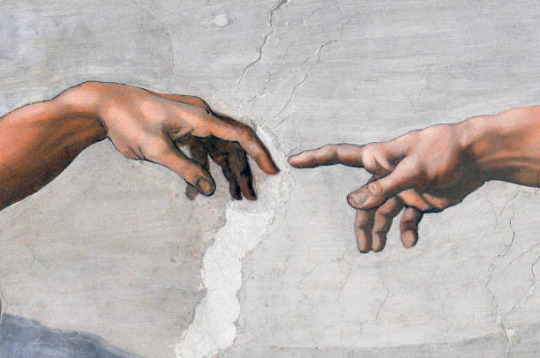
From the age of medieval art period to the age of Impressionism, Surrealism, cubism, and Renaissance the world of art has seen its fair share of influential movements.
Art something that’s very subjective yet is able to describe someone another’s feelings without using even a single word. While the style of art has changed over the years but the overall objective has stayed the same.
Producing quality and thought-provoking work, the list of these artists are making waves in the contemporary art world.
Here are the 5 artists that have made huge impact in the world of contemporary art
1. Françoise Pétrovitch
With drawing at the heart of her practice, Pétrovitch also uses a range of other mediums including ceramics, glass, painting, and video. Her works often represent ambiguous beings that appear to be consumed by their thoughts.
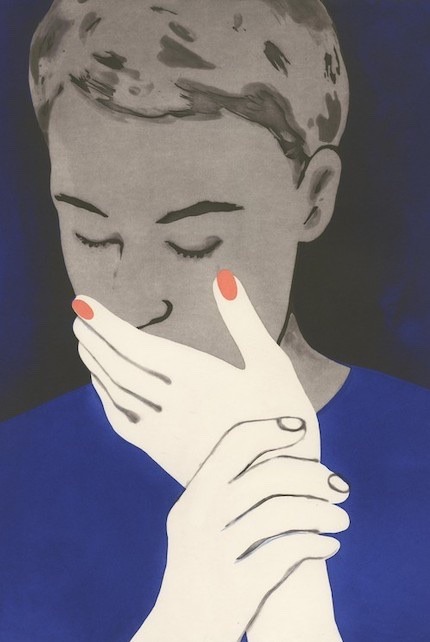
2. Tiemar Tegene
Ethiopian artist Tiemar Tegene employs varying techniques in her practice, with a focus on etching. Her work explores the natural and constructed boundaries that exist within us all, specifically in relation to power and control.
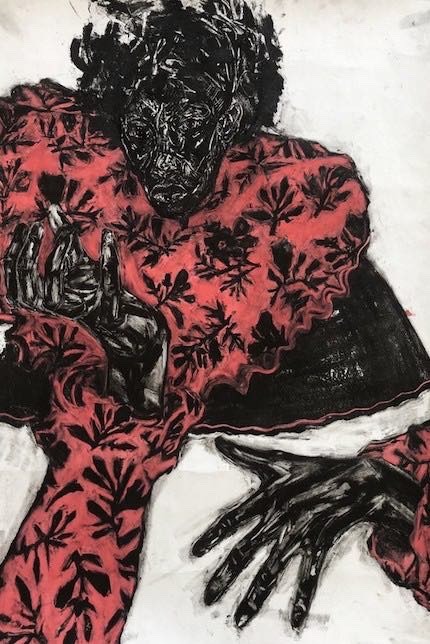
3. Okuda
Beneath the colorful surface of Spanish artist Okuda‘s works lies a deeper meaning. Switching between digital art and traditional methods like embroidery, Okuda explores the meaning of life and the conflicts that exist in humanity.

4. Maria Esmar
Abstract painter Maria Esmar‘s expressive canvases brighten up any interior space with their colorful and harmonious compositions. The artist’s impressive output has drawn attention to her work
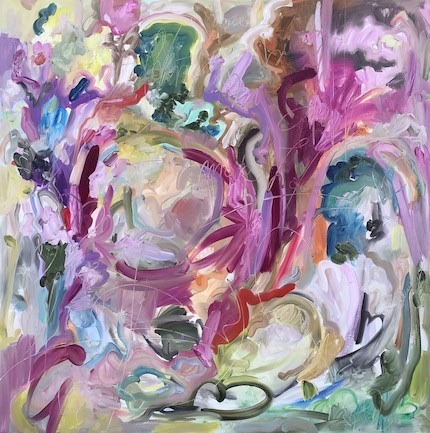
By,
Ritika Rajpal
10 notes
·
View notes
Text






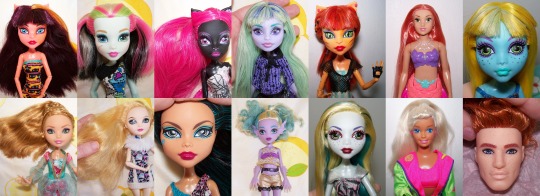
I should probably make a scavenging tag to keep tab of this buuuut it kind of goes under the home hacks and multipurpose crafting i've been doing ever since that first 2008 doll streaks with gold embroidery floss rooted using a toothbrush handle with the needle inserted by melting over a candle.
Guess this is kind of my brand. ¯\_(◡‿◡)_/¯
On Friday, I walked Lily briefly and found a big bin bag that was someone's chest of drawers emptied so I sorted it into clothes, recyclable and rubbish put it all in the correct bins and left the clothes and accessories for others to go through after picking out a few gorgeous scarves, a brand-new djellaba in bronze cotton, a lovely stained cream jumper (sweater) that i'm going to dye: it had a snagged loose knit - crochet looking but done by machine - back that just needed re-knotting/rethreading (what ever the word is for when you use tweezers to weave the yarn back through its original pattern and knot it down), a machine knitted snood to frog/unravel, some glitter body lotion and a notebook.
*I found the glue at another bin next to a bunch of tools (including a stainless ratchet wrench 😍 with accessories I couldn't carry 😥) thought I'd grab the glue in case there was a chance you could get some out by using a pin through the top as I'm currently waiting for superglue in the mail. Score: It's not jammed at all.
Loctite powerflex is pricey (€7 for 3g when you can get 20 x 3g liquid superglue for €4) and takes about double the time to set (hold tight and count to at least sixty not thirty) but it is magical stuff: not only does it go where you direct it to, you have a window to wipe off any excess without it leaving damage and it holds really well without cracking on flexible surfaces like vinyl, shoe soles, headphone wires. It's got superglue in it but also some kind of rubber base solution. It's one of those fancy glues you want around for the special stuff while having a backup of bog-standard superglue for basic repairs.
*I keep sleep and symptom notebooks to keep track of any circadian rhythm disruptions, migraines, gastrointestinal issues so I can circle back to a particular food or activity. I'd been using these cute panda shaped accounting notepads and stocked up but as with all things good, they got discontinued. I tried other notepads but it wasn't quite right: it needs to be lightweight, easily replaceable if I drop water on it, as unobtrusive as possible. This merch pocket book with the 5mm squares is just right when unbound into 6.
/// I learned this trick as a kid, someone showed me how different books were bound and how to salvage thrown out school exercise books, remelt crayons, use carbon copy, properly wash brushes... that kind of stuff. I think it was a free summer art class where you turn up and there are all sorts of different people and even if you end up just drawing ye olde square house, you absorb a bunch of history or techniques and get to watch other people: how they sketch, how they observe, I think that was the first time i'd seen cross-hatching and then couldn't unsee it in illustrations. I'm so glad my parents dropped me off at the various council, museum and church free events as a kid: some are really rigid and you get in trouble if you don't assemble the pompom bird exactly as instructed, others are an occasion to bond with some grandpa who'll show you how to whittle or learn and learn. ///
Why not go digital? because you don't want your phone on: you'll forget what you were supposed to do and go down a rabbit hole. Besides, half those things come with weird reward systems that make me feel obligated or guilty, or worse: diet propaganda. So that lil find has me set for the next year, I transcribed my current messy too big notepad into two pages and voilà! (well i still have a couple of symptoms to add now that i look it over)
*After working with yarn for a while, you start to get a sense for the type that doesn't pull apart when brushed or tugged and it's rarer than you'd expect so I took the snood despite not liking the green tinge to the mustardy colour: it doesn't make clawdeen's skin tone pop for example. So it's the right fibre with a light enough base for some dye experiments.
*it has taken forever and it's just a start (50+ more) but I have listed 12 more dolls on ebay!! there are reroots from before I got injured and deglued dolls i'm really proud of. If you're interested, I'd much prefer to sell in bulk to the EU, will happily sell at cost instead of those higher ebay prices and have a ton of doll heads and partially finished projects if you repaint or reroot.
8 notes
·
View notes
Note
First, gotta put food on big textiles back, that’s going to live in my mind for while. Okay business: I’m at the end of my rope rn. I do Not know a lot about textiles. I need to know about ribbons in the Middle Ages. I don’t know how much you know or care about textiles from that period or any adjacent period pre-enlightenment would work great too, but if you have any idea where to point me to learn? I just don’t know where to look. Google is not helpful. It’s mostly ribbon/brocade sellers and a few limited articles from colleges and hobbyists, very limited in scope and information and not really any of that info helpful to me u feel. If you have any idea a better place for me to look for information… I would be so grateful. Even if not, thank you for fighting the good fight and putting food on big textiles back 🫡
lmao that's a riff on other people's riffs on a George W-ism ("put food on your family")
I am not knowledgeable about textiles at all but I would definitely recommend browsing the book collection on archive.org, it has tools for searching the metadata and text of books.
I've used it a lot to look at old books for surface embroidery/darning techniques that have fallen out of popularity and don't have a real digital footprint (at least in english)
would also maybe check out
2 notes
·
View notes
Text
East Meets West: Bridging Fashion from Burberry to Sabyasachi and Papa Don't Preach by Shubhika
This case about Burberry made me think of Indian fashion and the axis of traditionality/heritage to modernity. It’s fascinating to see how global brands like Burberry parallel or diverge from Indian counterparts like Sabyasachi and Papa Don't Preach by Shubhika, especially in their approach to blending heritage with modern trends.
Burberry's Timeless Elegance
Burberry, with its quintessentially British roots, stands as a pillar of luxury and tradition. Famous for its classic trench coats and the iconic check pattern, the brand merges historical elements with modern needs seamlessly. Under leaderships like Angela Ahrendts', Burberry expanded its reach while keeping a tight grip on its classic British heritage, ensuring that each piece tells a story of timeless elegance.
Sabyasachi's Regal Craftsmanship
Crossing over to India, Sabyasachi is a brand that echoes similar sentiments but in a decidedly Indian context. Sabyasachi Mukherjee, the founder, emphasizes the grandeur of India’s artisan traditions. His designs are a homage to the past—lush fabrics, intricate embroideries, and vibrant palettes that speak volumes of India’s rich textile legacy. Much like Burberry, Sabyasachi caters to an elite clientele, offering pieces that combine the old-world charm with contemporary silhouettes.
Papa Don't Preach by Shubhika's Bold Modernity
On the other end of the spectrum is Papa Don't Preach by Shubhika, a label that challenges traditional norms and embraces a more rebellious, modern aesthetic. Shubhika Sharma’s creations are colorful, edgy, and experimental, incorporating unconventional materials and bold designs that stand out in a crowd. This brand caters to a younger, more daring demographic, looking to make a statement rather than adhere to classic styles.
Comparative Analysis: Tradition and Innovation
What’s interesting is how each of these brands, though operating in different cultural and market contexts, manages to find a balance between tradition and innovation. Burberry, maintaining its luxury heritage, adapts to the modern market with digital integration and global expansion strategies. Sabyasachi, while deeply rooted in Indian craftsmanship, continues to evolve, embracing new techniques and styles to keep his designs fresh and relevant.
Papa Don't Preach by Shubhika represents a leap towards modernity, focusing less on tradition and more on creating new trends and expressions in fashion. This brand is much like the new voices in the fashion industry worldwide, which prioritize breaking norms and setting new boundaries.
Conclusion: A Tapestry of Styles
The comparison between Burberry, Sabyasachi, and Papa Don't Preach by Shubhika illustrates a global tapestry of styles where every thread counts. Each brand, whether British or Indian, tells a story through its fashion, influenced by its heritage but driven by the modern world's demands. As global consumers become more interconnected, the influence of traditional and modern design elements blends even more, creating exciting, dynamic fashion landscapes for us to explore.
These brands show that whether in the lush countryside of England or the bustling streets of Mumbai, fashion remains a universal language, spoken fluently with both classic and contemporary dialects.
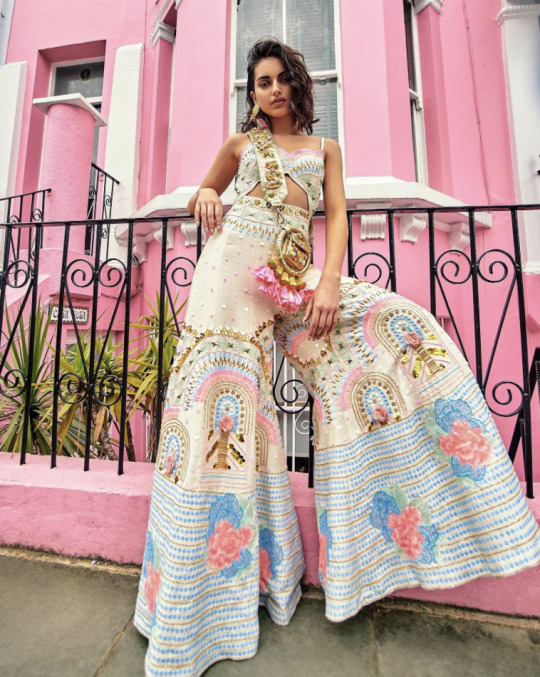
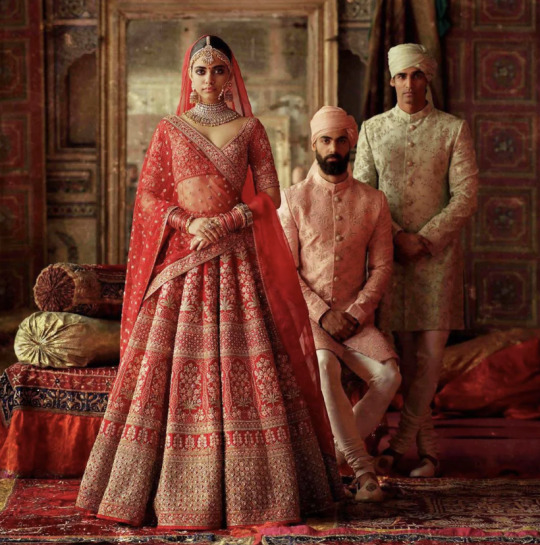
2 notes
·
View notes
Note
what stitching technique do you use for your plushies and how long does it take for you to make one?
just a running stitch and with the designing, digitizing, embroidery, and sewing, usually about a week in my free time
8 notes
·
View notes
Text
Just some rambling about machine embroidery digitizing to follow up the last post:
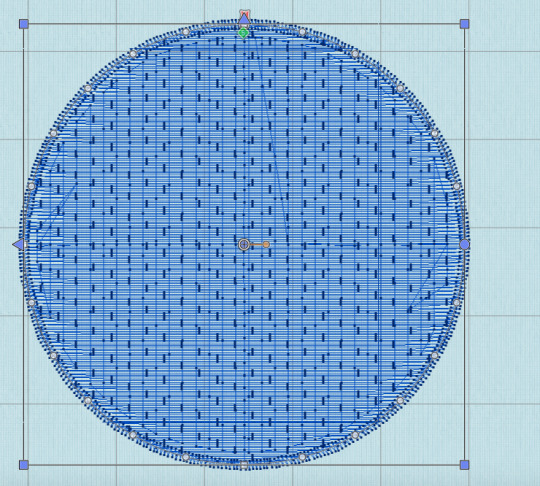
This is one kind of pattern fill. A pattern fill is basically the software filling a space in with horizontal lines of stitching. The pattern is determined by where the machine makes the stitches. This can be generic, or it can be used to make certain textures or designs.

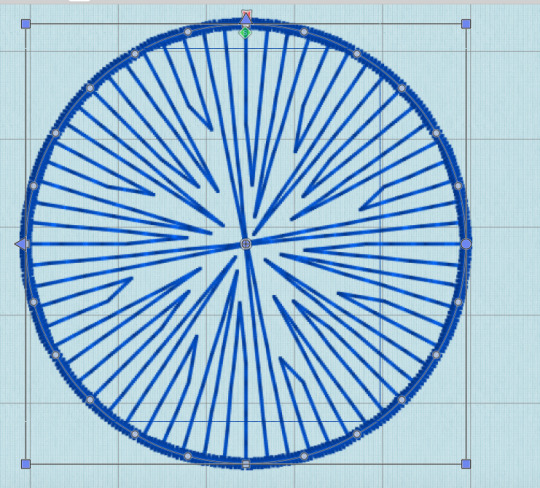
This is a spiral fill and a radial fill, as my software intends you to use them. You can decrease or increase the density of the stitching, but both are default to allow you to see the fabric behind them.
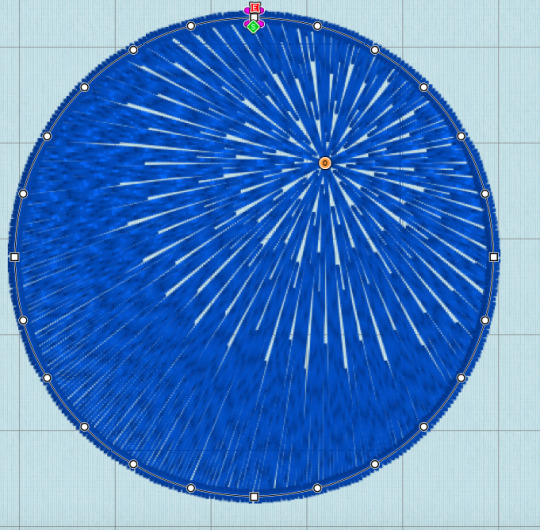
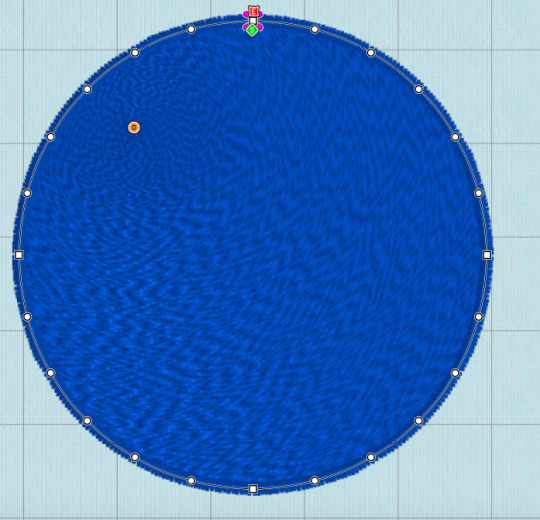
This is how I use radial and spiral fills. I increase the density, sometimes even more than I did in these images, and I change the point of origin. In general, the point of origin on a radial fill will be the lightest point, and the point of origin on a spiral fill will be the darkest point. You can use this to add subtle shading or to change the visual shape of something. You can even move the point of origin so that it's not in the shape at all, which can allow you to do additional techniques.
Digitizing embroidery is more than just tracing the areas you want with vectors. Embroidery is vector art that travels in time and space. Take advantage of your tools to shape your needs.
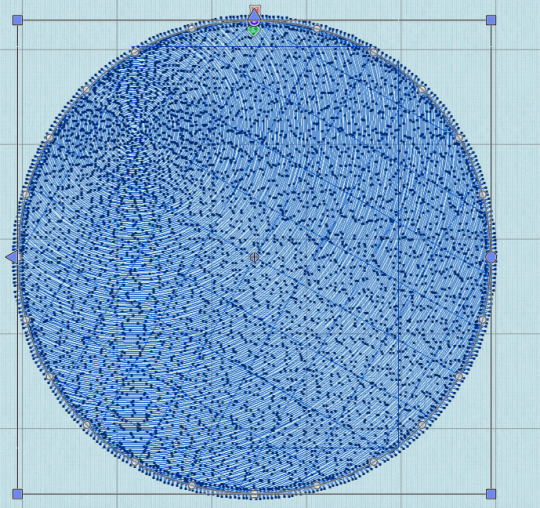
If you want to do a fast and cheap underlay for these, which is an underlay that's technically not correct, but is fast and looks okay, here's my strat.
You duplicate the shape and move the duplicate under the original. Then, you just remove the border line and fill it with a cross hatch, about 3-4mm apart and with a stitch length of like 5-7mm. The closer together the stitches are (like in this spiral fill), the closer you can have your cross hatch. You can make the stitches shorter, too, but you can still keep them significantly longer than normal stitches are. Remember that the underlay is to support the fabric, not to put strain on the fabric. This is not the correct way to make an underlay, but we're also not using spiral fills or radial fills correctly. Technically, you want the underlay to go at a 90 degree angle to the topstitching, and we can't exactly do that when everything is a spiral or a radial fill, so we're going to cheat and just let whatever happens happen.
#machine embroidery#i love this element of is so much#like yes you have had the shape but what about the fill style#what about second underlay
29 notes
·
View notes
Text
Digital Print Kurta for Men in Borivali:
Digital print kurtas for men in Borivali represent a modern and innovative approach to traditional Indian attire. These kurtas feature designs digitally printed directly onto the fabric, offering a departure from conventional handcrafted techniques. Unlike the time-consuming processes of block printing or embroidery, digital print kurtas in Borivali allow for intricate and customizable patterns that cater to contemporary fashion preferences.
The emergence of digital print kurtas has transformed the world of men’s ethnic wear in Borivali. These garments present a plethora of advantages, such as access to a diverse range of vibrant and unique designs, quick availability, and the option for customization to match individual style and special occasions.
When seeking the perfect digital print kurta for men in Borivali, it’s crucial to consider factors like the quality of the digital prints, the choice of materials (cotton, silk, and more), pricing, and the provider’s ability to cater to specific design preferences. Borivali, a bustling city within Mumbai, offers a thriving marketplace for digital print kurtas, providing a fusion of tradition and contemporary style in men’s fashion.
2 notes
·
View notes